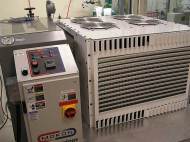Microchannel heat exchangers improve thermally activated cooling systems
 Engineers at Oregon State University (OSU) have made a major step toward addressing one of the leading problems in energy use around the world today – the waste of half or more of the energy produced by cars, factories and power plants. They have built a prototype which captures and uses the low-to-medium grade waste heat that’s now going out the exhaust pipe of millions of automobiles, diesel generators, or being wasted by factories and electrical utilities.
Engineers at Oregon State University (OSU) have made a major step toward addressing one of the leading problems in energy use around the world today – the waste of half or more of the energy produced by cars, factories and power plants. They have built a prototype which captures and uses the low-to-medium grade waste heat that’s now going out the exhaust pipe of millions of automobiles, diesel generators, or being wasted by factories and electrical utilities.
“This could become a very important new energy source and way to improve energy efficiency”, said Hailei Wang, a research associate in the School of Mechanical, Industrial and Manufacturing Engineering at OSU. “The prototype shows that these systems work as well as we expected they would.”
More than half of the heat generated by industrial activities is wasted in the usual technology around us, and even very advanced electrical power plants convert only about 40 percent of the energy produced into electricity. The internal combustion engines of automobiles generally operate around 25 to 40 percent of conversion efficiency.
Various approaches have been attempted, and are sometimes used, to capture and use at least some of that waste heat to produce cooling. The new system being developed at OSU called a “thermally activated cooling system” is capable to perform this task more efficiently than past approaches, while it is also more portable, and capable to produce electricity.
The new approach gains much of its efficiency by using extraordinarily small microchannels, developed at Microproducts Breakthrough Institute which is operated by OSU and the Pacific Northwest National Laboratory, which increase the performance, while lowering size and weight of the device. It effectively combines a vapor compression cycle with an “organic Rankine cycle” – an existing energy conversion technology.
The new prototype completed at OSU succeeded in turning 80 percent of every kilowatt of waste heat into a kilowatt of cooling capability. Researchers say the conversion efficiency wouldn’t be nearly as high if the goal is to produce electricity (about 15-20 percent) but it’s still much better than the current approach, which is to waste the energy potential of all of the heat.
“This technology would be especially useful if there’s a need to have cooling systems where heat is being wasted”, Wang said. “That’s one reason the research has been supported by the Department of Defense, because they see it being used to provide needed air conditioning for electronics and other purposes when they are using generators in the field.”
However, the OSU scientists said that may be just the beginning. Factories often produce enormous amounts of wasted heat in their operations. The systems could also be incorporated into alternative energy technologies such as solar or geothermal, scientists say, in addition to fossil fuel use.
According to researchers, it should also be possible for such systems to be used in hybrid automotive technology, taking waste heat from the gasoline engine and using it not only for air conditioning but also to help recharge the battery that powers the vehicle.
The potential cost savings, improved energy efficiency and broad application of such technology is enormous. The new systems now being perfected at OSU should be able to use much of that waste heat either in cooling or the production of electricity.
For more information, you can read the article named: “Performance Enhancement of a Thermally Activated Cooling System Using Microchannel Heat Exchangers”.









Leave your response!